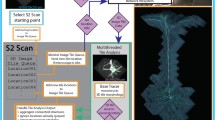Abstract
Digital reconstruction of 3D neuron structures is an important step toward reverse engineering the wiring and functions of a brain. Toward this end, the BigNeuron project bench testing was launched to gather a worldwide community to establish a Big Data resource and a set of the state-of-the-art of single neuron reconstruction algorithms for neuroscience community. As one of the communities, we contribute a Mean shift and Minimum Spanning Tree (M-MST) algorithm to trace single neuron morphology. In our experiment, we have successfully reconstructed 120 Drosophila neurons by using the M-MST algorithm and achieved relatively good difference scores compared with other four algorithms by using APP2 as a reference object.
Access this chapter
Tax calculation will be finalised at checkout
Purchases are for personal use only
Similar content being viewed by others
References
Meijering, E.: Neuron tracing in perspective. Cytom. A 77, 693–704 (2010)
Peng, H., Meijering, E., Ascoli, G.A.: From DIADEM to BigNeuron. Neuroninformatics 13, 259–260 (2015)
Pal, S.K.: Fuzzy sets in image processing and recognition. In: IEEE International Conference on Fuzzy Systems, San Diego, CA, pp. 119–126 (1992)
Malladi, R., Sethian, J.A.: Level set and fast marching methods in image processing and computer vision. In: International Conference on Image Processing, Lausanne, pp. 489–492 (1996)
Xiao, H., Peng, H.: APP2: automatic tracing of 3D neuron morphology based on hierarchical pruning of a gray-weighted image distance-tree. Bioinformatics 29, 1448–1454 (2013)
Wang, Y., Narayanaswamy, A., Tsai, C.-L., Roysam, B.: A broadly applicable 3-D neuron tracing method based on open-curve snake. Neuroinformatics 9, 193–217 (2011)
Cai, H., Xu, X., Lu, J.: Repulsive force based snake model to segment and track neuronal axon in 3D microscopy image stacks. NeuroImage 32, 1608–1620 (2006)
Peng, H., Ruan, Z., Atasoy, D., Sternson, S.: Automatic reconstruction of 3D neuron structures using a graph-augmented deformable model. Bioinformatics 26, 38–46 (2010)
Cai, H., Xu, X., Lu, J.: Using nonlinear diffusion and mean shift to detect and connect cross-selections of axons in 3D optical microscopy images. Med. Image Anal. 12, 666–675 (2008)
Oliver, A., Munoz, X., Batlle, J., Pacheco, L., Freixenet, J.: Improving clustering algorithms for image segmentation using contour and region information. In: IEEE International Conference on Automation, Quality and Testing, Robotics, Cluj-Napoca, pp. 315–320 (2006)
Wu, J., He, Y., Yang, Z., Guo, C., Luo, Q., Zhou, W., Chen, S., Li, A., Xiong, B., Jiang, T., Gong, H.: 3D BrainCV: simultaneous visualization and analysis of cells and capillaries in a whole mouse brain with one-micron voxel resolution. NeuroImage 87, 199–208 (2014)
Yang, J., et al.: A distance-field based automatic neuron tracing method. BMC Bioinform. 14, 93 (2013)
Acknowledgements
This work was funded by National Basic Research Program of China (2014CB744600), International Science & Technology Cooperation Program of China (2013DFA32180), National Natural Science Foundation of China (61420106005, 61272345), and JSPS Grants-in-Aid for Scientific Research of Japan (26350994), and supported by Beijing Municipal Commission of Education, and Beijing Xuanwu Hospital.
Author information
Authors and Affiliations
Corresponding author
Editor information
Editors and Affiliations
Rights and permissions
Copyright information
© 2016 Springer International Publishing AG
About this paper
Cite this paper
Wan, Z., He, Y., Hao, M., Yang, J., Zhong, N. (2016). An Automatic Neuron Tracing Method Based on Mean Shift and Minimum Spanning Tree. In: Ascoli, G., Hawrylycz, M., Ali, H., Khazanchi, D., Shi, Y. (eds) Brain Informatics and Health. BIH 2016. Lecture Notes in Computer Science(), vol 9919. Springer, Cham. https://doi.org/10.1007/978-3-319-47103-7_4
Download citation
DOI: https://doi.org/10.1007/978-3-319-47103-7_4
Published:
Publisher Name: Springer, Cham
Print ISBN: 978-3-319-47102-0
Online ISBN: 978-3-319-47103-7
eBook Packages: Computer ScienceComputer Science (R0)




